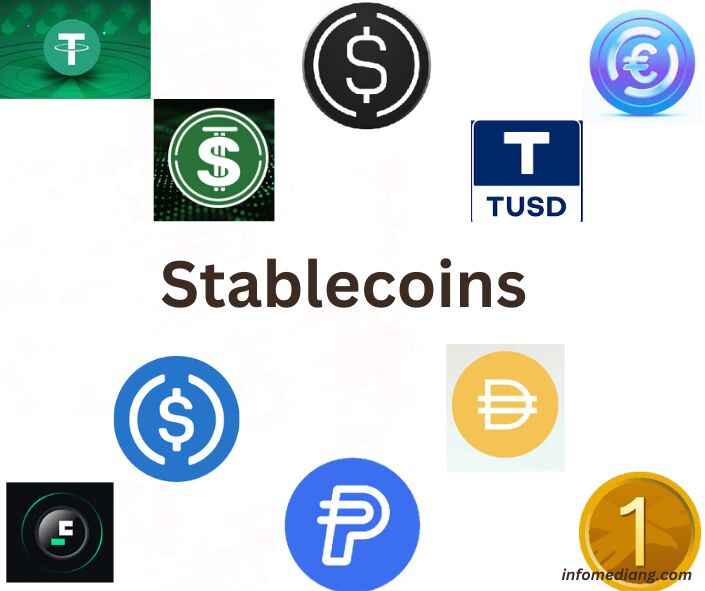The recent growth of stablecoins such as USDt, USDC, USDe, among others—especially among business owners—is not far-fetched from the fact that they are more likely to retain their value than other extremely volatile cryptocurrencies.
For startups that want to key into the use of stablecoins as a method of payment, here are the things you need to know about them and how they work.
What is stablecoin?
A stablecoin is a type of cryptocurrency pegged to a specific asset such as fiat currency (e.g., USD, GBP, NGN, etc.), exchange-traded commodities such as gold, or another cryptocurrency. The main idea behind stablecoin is to maintain stability in value against the asset it is pegged to.
Stablecoins come from “stable” and “coins” (that is, digital assets). They are created to serve as an alternative to the more volatile cryptocurrencies (e.g. Ethereum, Bitcoin). They are attractive to traders and business owners because they offer stability and efficiency. There are currently over 200 stablecoins in the market, with Tether (USDT) leading the pack with over 60% market share.
Stablecoin helps mitigate unpredictable price swings that are peculiar to other cryptos when their value is pegged to real-world assets or commodities. Stablecoins are reserve-backed if they are managed in good faith—if they are not managed by people who have ulterior motives, such as Do Kwon, founder of USDT.
Typology of stablecoin
- Stablecoin types by backing
- Stablecoin yypes by market capitalization (strength)
When we consider the types of stablecoins by backing, then we have:
- Fiat-backed
- Crypto-backed
- Commodity-backed
Types stablecoin by backing
Fiat-backed
When a stablecoin is fiat-backed, it means the value of the stablecoin is based on the value of the backing currency. Fiat-backed coins are held by a third-party regulated financial entity. Fiat-backed stablecoins are traded on crypto exchanges such as Binance, Coinbase, and other exchanges, and they are redeemable from the issuer.
The issuer of a stablecoin in a fiat-based scenario must have the necessary fiat to make exchanges to maintain stability in its value. The issuer of UST didn’t have the necessary fiat to support the coin in 2022, and within days, the value of UST fell from $1 to 26 cents.
The amount of the currency used to back the stablecoin should reflect the circulating supply of the stablecoin.
The most widely used stablecoin company, Tether, once claimed that it had enough fiat to support exchanges between 2016 to 2018, but an investigation by the Commodity Futures Trading Commission revealed that the company only had 27.6 percent of fiat reserves to guarantee USDt. The company was fined $41 million for deceiving its customers—to serve as a deterrent to other players that might want to engage in such unethical practices.
Commodity-backed
The value of a commodity-backed stablecoin is fixed to one or more commodities and is redeemable for such on demand. Tether Gold (XAU₮), for instance, is backed by physical gold, which provides you ownership on a 1:1 basis of one fine troy ounce of gold on a physical bar of gold.
Similarly, the amount of the commodity used to back the stablecoin should reflect the circulating supply of the stablecoin.
Cryptocurrency-backed
Similar to fiat-backed stablecoins, cryptocurrency-backed stablecoins are issued with cryptocurrencies as collateral. The difference between fiat-backed and crypto-backed is that while fiat collateralization happens off the blockchain, the digital asset used to back crypto-backed is done on the blockchain with the use of smart contracts in a more decentralized way.
The unique feature of this type of backing is that the peg is implemented on-chain via smart contracts. However, cryptocurrency-backed stablecoin is more technical and complex than fiat-backed. It has a greater risk of exploits should there be bugs in the smart contract code.
Types stablecoins by marketcap
By marketcap, there are more than 233 stablecoins in the crypto market with over $253 billion market capitalisation, below are some of the stablecoins by their market capitalization
- Tether (USDT) – $154,849,070,550
- USDC – $61,087,054,317
- Ethena USDe – $5,891,550,206
- Dai (DAI) – $5,365,759,691
- World Liberty Financial USD – $2,182,250,861
- First Digital USD – $1,555,615,726
- PayPal USD (PYUSD) – $1,003,559,459 etc
How crypto traders use stablecoin
In the cryptocurrency market, it is more likely that a trader converts their digital assets to a specific stablecoin during volatility. They do this to minimize losses.
For instance, if you see the price of Bitcoin (BTC) dropping from, say, $105K to $95K within minutes and it continues to drop due to some factors, and you as a trader are not comfortable with it, you can quickly move it to, say, USDt or another stablecoin. For instance, USDt/USD is 1:1 ratio. This way, when you notice the price of BTC going back up, you can convert your USDt back to BTC or whichever digital asset you are trading.
Consortium Naira (cNGN) is pegged against the Nigerian Naira, Tether’s USDt is pegged against the US Dollar—meaning someone who receives cNGN will receive the actual value of Naira, and so also with USDt. If there is going to be a difference, it is going to be cent differentiation. In most cases, you get the same value as the stablecoin—unlike other cryptocurrencies that drop within seconds of a transaction.
Instances of Stablecoin collapse
Theoretically, 1:1 pegging by a reference asset can make a stablecoin’s value track the value of the peg and not be subject to the instability that is peculiar to other digital assets such as BTC and ETH.
Practically, however, there have been a number of stablecoins that collapsed, making holders lose almost their entire holdings.
For instance, the value of UST fell from $1 to 26 cents on May 11, 2022, which led to about $40 billion loss for those who invested in Terra and Luna coins. UST was a stablecoin founded by Do Kwon of Terraform Labs. He is now wanted by authorities in the United States for prosecution.
Another case of stablecoin collapse called Basis was in December 2018. Even though the company received more than $100 million in venture capital funding, it closed shop citing unfriendly U.S. regulations.
Despite the two instances of collapse above, stablecoin is still more stable than other digital assets. Also, the crypto market has witnessed more non-stablecoin crypto firms collapse than core stablecoin firms.
Advantages of stablecoin
According to the Bank for International Settlements, some of the benefits of stablecoin in the crypto market and in the financial sector are:
Anti-money laundering: It enhances anti-money laundering efforts by the government.
Financial inclusion: It promotes financial inclusion, most especially if it is fiat-backed.
Price stability: The ability of the stablecoin to maintain a stable value makes it stand as a shock absorber for the cryptocurrency market. When other cryptos are volatile, stablecoin remains stable, thereby standing in as a controller of crypto volatility.
That’s why traders are more comfortable converting their BTC or ETH or other volatile digital assets to stablecoins whenever there is high volatility in the market.
Customer data: It gives the government the regulatory role of protecting customer data, if it is used in a country that takes citizens’ data seriously.
Valuable in the financial ecosystem: Stablecoins are valuable tools in both the cryptocurrency ecosystem and broader financial markets.
It promotes cybersecurity
It enhances tax compliance
Disadvantages
There are also some drawbacks to the growth of stablecoin around the world. Some of them include:
Limitations on regulation: At the time of publication, Consortium Naira (cNGN) is still having a limited supply of only 4,400 cNGN coins in circulation. While some analysts opine that limited supply could affect trading dynamics, some say the regulators are behind the limitation because of fear of being exploited by bad political elites as a tool to stack their illicit funds.
Similarly, Nellie Liang, an economist who served as the U.S. Under Secretary of the Treasury for Domestic Finance during the administration of former President Joe Biden between 2021 and 2025, expressed concerns over the growth of stablecoins and called for “urgent Congressional regulation.” She says stablecoin use requires clarity, while delivering a speech to the Stanford Graduate School of Business in November 2021.
Transparency concerns: A year ago, it took the Commodity Futures Trading Commission intense digging to discover that Tether, the largest stablecoin firm, deceived its customers about the amount of fiat reserves it had to guarantee USDt.
Although Tether was fined $41 million, these issues of transparency are a big problem in the market. The company was also accused of failing to produce audits for reserves used to collateralize the quantity of minted USDT stablecoin.
The same transparency concern can be said of Terra, which crashed in 2022 after projecting a stablecoin product and deceiving users and investors until it crashed to zero.
Yes, stablecoin can crash if the company behind it is not transparent about holdings. Examples of stablecoins that have crashed are Basis, Terra and Luna coins, Diem (formerly Libra). Some stablecoins are still in the market may be able to stand the competition.
Bitcoin is not stablecoin. While stablecoin has a fixed value, BTC does not have a fixed value
There are 233 stablecoins listed on CoinMarketCap as at June 8, 2025, the figure may change as companies come into the sector.
USDT, the “T” stands for Tether while Tether is a company, USD is United States Dollar. Then the company behind the stablecoin came up with USDT pegged at 1:1 ration.


